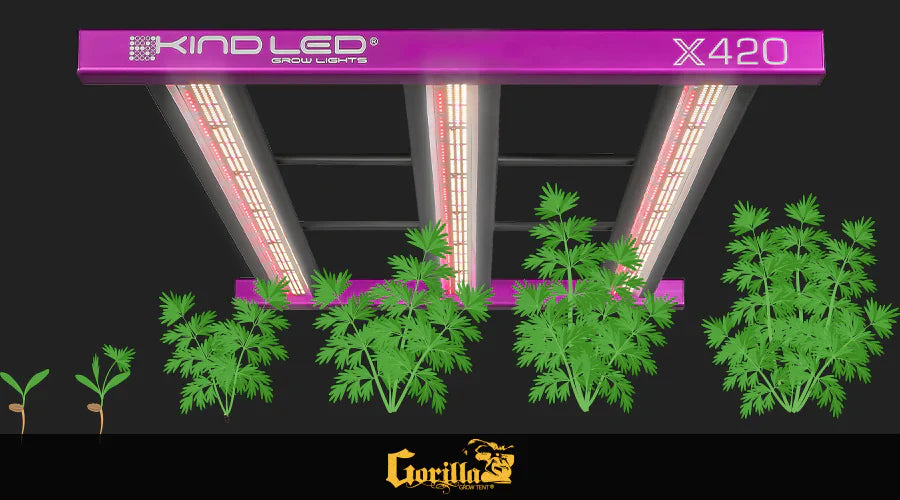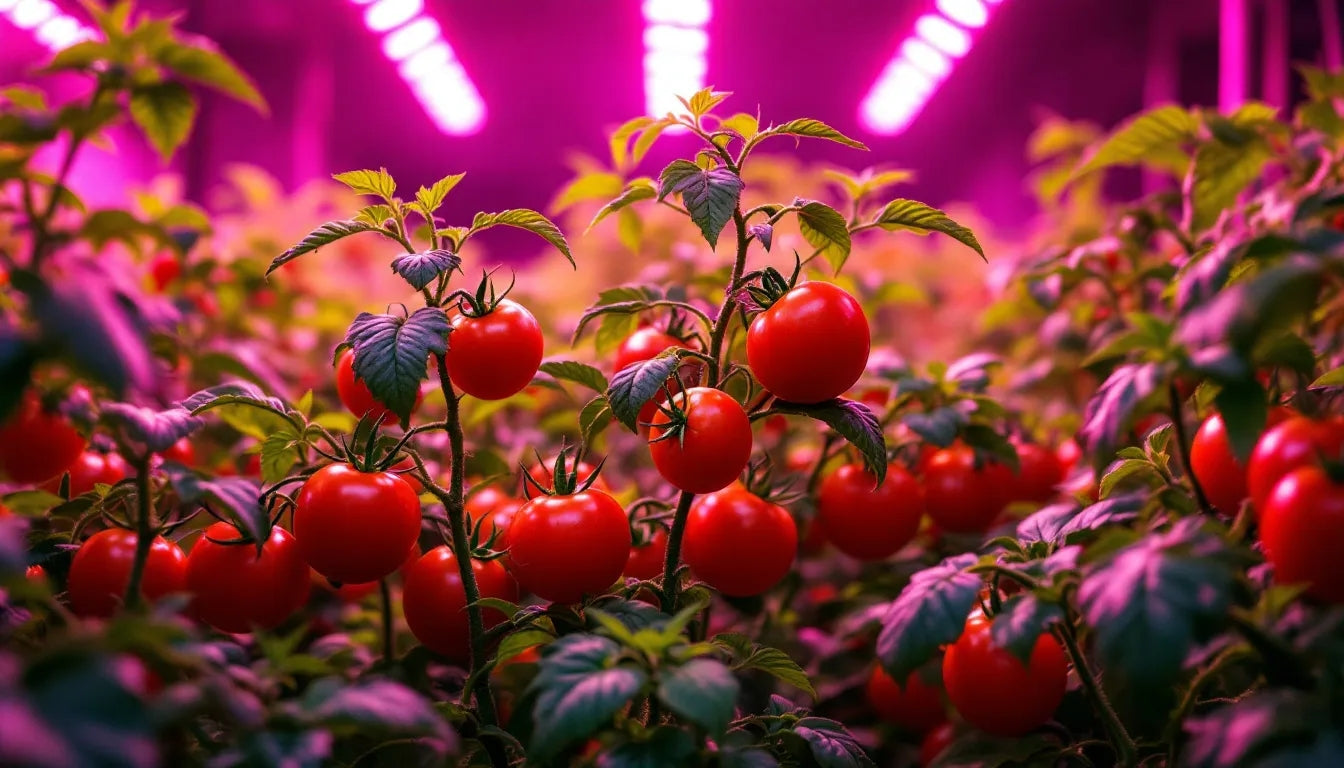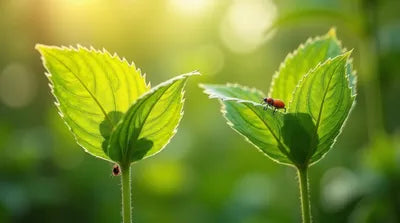
LED Grow Light Distance Chart: Optimal Height for Each Growth Stage
Proper LED grow light positioning is the cornerstone of successful indoor growing. Too close and you risk light burn, heat stress, and stunted development. Too far and plants stretch, yields suffer, and energy is wasted. This comprehensive distance chart provides precise hanging heights for every growth stage, helping you maximize photosynthetic efficiency while preventing costly mistakes that can destroy entire harvests.
Quick Answer: LED grow light distances vary by growth stage and wattage: Seedlings need 24-36 inches, vegetative growth requires 18-24 inches, and flowering stage demands 12-18 inches from canopy. Lower wattage lights (100-300W) can be positioned closer, while high-power LEDs (600W+) need greater distances. Always monitor PPFD levels (200-400 μmol/m²/s for seedlings, 400-600 for vegetative, 600-1000 for flowering) and adjust based on plant response.
Understanding the Science Behind LED Light Distance
The Inverse Square Law and Light Intensity
Light intensity follows the inverse square law, meaning that doubling the distance reduces light intensity by 75%. This exponential relationship makes precise positioning critical for optimal plant development. Modern LED grow lights provide unprecedented control over light distribution, making accurate distance measurements more important than ever.
Key scientific principles:
- Intensity decreases rapidly with distance: Moving from 12" to 24" reduces intensity by 75%
- PPFD (Photosynthetic Photon Flux Density): Measures actual usable light reaching plants
- Heat management: LED efficiency allows closer positioning than traditional lighting
- Spectrum penetration: Different wavelengths penetrate canopy at varying rates
PPFD Requirements by Growth Stage
Professional growers rely on PPFD measurements rather than simple distance charts because different LED models produce varying intensities. Understanding PPFD for seedlings and mature plants ensures optimal photosynthetic efficiency.
PPFD targets by growth stage:
- Seedlings/Clones: 200-400 μmol/m²/s for healthy establishment
- Vegetative Growth: 400-600 μmol/m²/s for robust development
- Flowering Stage: 600-1000 μmol/m²/s for maximum bloom production
- Light-sensitive plants: Start at lower PPFD levels and gradually increase

Comprehensive LED Distance Chart by Wattage
Low Wattage LEDs (100-300 Watts)
Low wattage LED systems provide excellent control for small spaces and sensitive plants. The Gorilla Xi220 exemplifies this category, crushing 2x2 to 2x2.5 spaces with concentrated power.
Distance recommendations:
- Seedling Stage: 18-24 inches from canopy
- Vegetative Stage: 12-18 inches from canopy
- Flowering Stage: 8-12 inches from canopy
- Coverage Area: 2x2 to 3x3 feet optimal
Benefits of low wattage positioning:
- Precise control: Easy fine-tuning for plant response
- Heat management: Minimal thermal stress on plants
- Energy efficiency: Maximum photon utilization
- Flexibility: Quick adjustments as plants develop
Medium Wattage LEDs (300-500 Watts)
Medium wattage systems offer the sweet spot for most home growers, providing excellent coverage and intensity. The Gorilla Xi330 and Xi420 deliver targeted full spectrum performance for 2x3 to 3x4 growing environments.
Distance recommendations:
- Seedling Stage: 24-30 inches from canopy
- Vegetative Stage: 18-24 inches from canopy
- Flowering Stage: 12-18 inches from canopy
- Coverage Area: 2x4 to 4x4 feet optimal
Xi420 specific advantages:
- Tri-channel spectrum control: Adjust blue, red, and far-red independently
- Smart automation: GXi wireless intelligence for automated adjustments
- Superior heat management: Closer positioning than comparable lights
- Professional results: Maximizes production in compact spaces
High Wattage LEDs (600+ Watts)
High-power LED systems deliver commercial-grade intensity for maximum yields. The Gorilla Xi750 commands 4x4 to 5x5 areas with uncompromising intensity while maintaining optimal heat management.
Distance recommendations:
- Seedling Stage: 30-36 inches from canopy
- Vegetative Stage: 24-30 inches from canopy
- Flowering Stage: 18-24 inches from canopy
- Coverage Area: 4x4 to 6x6 feet optimal
High wattage considerations:
- Professional monitoring: PPFD meters essential for precise positioning
- Environmental control: Enhanced ventilation may be required
- Gradual adjustments: Small distance changes create significant intensity differences
- Maximum yields: Proper positioning delivers exceptional harvest weights
Stage-Specific Distance Guidelines
Seedling Stage: Critical First Weeks
Seedlings are most vulnerable to light stress, requiring gentle conditions that promote healthy establishment without shock. Proper seedling PPFD management sets the foundation for exceptional plant development.
Seedling distance parameters:
- Duration: First 2-3 weeks from germination
- Light schedule: 14-16 hours daily for optimal development
- Environmental needs: Higher humidity (60-70%) with stable temperatures
- Signs of success: Compact growth with strong stems and healthy green color
Common seedling mistakes:
- Too much intensity: Causes stunted growth and leaf burn
- Inconsistent scheduling: Disrupts circadian rhythms
- Poor environment: Inadequate humidity stresses young plants
- Premature intensity increases: Shocking delicate plant tissues
Vegetative Stage: Building Plant Structure
Vegetative growth focuses on developing strong stems, robust root systems, and healthy leaf production. This stage tolerates higher light intensities while plants build the structure needed for heavy flowering.
Vegetative distance optimization:
- Duration: 4-8 weeks depending on desired plant size
- Light schedule: 16-18 hours daily for rapid development
- Intensity increases: Gradually raise intensity as plants mature
- Training opportunities: LST and SCROG techniques maximize light exposure
Vegetative growth indicators:
- Rapid leaf development: New growth every few days
- Strong stem formation: Thick, sturdy main stalks
- Healthy root expansion: White, fibrous root development
- Optimal internodal spacing: Compact growth between nodes
Flowering Stage: Maximum Light Intensity
Flowering stage demands the highest light intensities to drive bloom development and maximize yield potential. Plants can handle intense light during this phase as they focus energy on reproductive growth.
Flowering distance strategies:
- Duration: 8-12 weeks depending on variety
- Light schedule: 12 hours on/12 hours off for most plants
- Peak intensity: Maximum PPFD levels for genetic potential
- Environmental precision: Lower humidity and optimal airflow
Flowering success metrics:
- Dense bloom development: Tight, resinous flower formation
- Continued growth: Healthy development throughout flowering
- Proper maturation: Gradual changes in flower appearance
- Maximum yields: Heavy, well-developed final harvest

Advanced Distance Optimization Techniques
Using PPFD Meters for Precision
Professional growers rely on PPFD measurements for accurate light positioning rather than simple distance charts. PAR (Photosynthetically Active Radiation) meters provide real-time intensity readings across the growing area.
PPFD measurement best practices:
- Multiple readings: Check center, edges, and corners of coverage area
- Canopy level: Measure at actual plant height, not floor level
- Regular monitoring: Track changes as plants grow taller
- Environmental factors: Consider temperature and humidity effects
Professional measurement tools:
- Dedicated PAR meters: Most accurate for serious operations
- Smartphone apps: Basic measurements for home growers
- Built-in sensors: Some advanced LEDs include monitoring
- Data logging: Track patterns over complete growing cycles
Environmental Factors Affecting Distance
Light distance requirements change based on environmental conditions in your growing space. Optimal growing environments enhance light efficiency and plant response.
Temperature considerations:
- Cooler environments: Plants tolerate higher light intensities
- Warmer conditions: Increase distance to prevent heat stress
- Air circulation: Good airflow allows closer positioning
- Humidity levels: Higher humidity reduces light stress tolerance
Grow tent factors:
- Reflective walls: Increase effective light intensity
- Ventilation quality: Better airflow enables closer positioning
- Space constraints: Height limitations may require adjustments
- Multiple plants: Even light distribution across all plants
Smart LED Features and Distance Management
Modern LED grow lights incorporate intelligent features that simplify distance management while optimizing plant development. Advanced GXi technology eliminates guesswork through automated adjustments.
Smart automation benefits:
- Spectrum adjustments: Change light quality without moving fixtures
- Intensity ramping: Gradual increases prevent light shock
- Environmental responses: Automatic adjustments based on conditions
- Growth stage presets: Optimized settings for each development phase
GXi wireless intelligence features:
- Sunrise/sunset technology: Natural light transitions
- Pro-level scheduling: Complex timing for advanced techniques
- Environmental protection: Automatic adjustments for plant safety
- Remote monitoring: Smartphone control from anywhere
Plant Type Specific Distance Requirements
High-Light Plants
High-light plants tolerate and benefit from intense illumination during flowering. Best grow lights for high-light plants provide the intensity needed for maximum potency and yield.
High-light plant distance guidelines:
- Seedlings: 24-36 inches for gentle establishment
- Vegetative: 18-24 inches for rapid growth
- Flowering: 12-18 inches for maximum intensity
- Late flowering: May tolerate even closer positioning
High-light plant indicators:
- Thick, waxy leaves: Naturally adapted for intense light
- Dense growth patterns: Compact development under high PPFD
- High metabolic rates: Rapid nutrient and water consumption
- Strong stems: Robust structure supporting heavy flowers
Herbs and Vegetables
Herbs and vegetables generally require moderate light intensities and may show stress signs under excessive illumination. LED distance optimization for these crops focuses on healthy development rather than maximum intensity.
Herb and vegetable distances:
- Leafy greens: 12-18 inches throughout growth
- Herbs: 15-20 inches for aromatic oil production
- Fruiting vegetables: 12-24 inches depending on variety
- Root vegetables: Focus light on foliage development
Houseplants and Ornamentals
Houseplants and ornamental species often prefer lower light levels and may suffer under grow light intensities designed for production crops.
Ornamental plant considerations:
- Shade-loving species: 24-36 inches or indirect lighting
- Tropical plants: Moderate distances with higher humidity
- Flowering ornamentals: Seasonal adjustments for bloom cycles
- Foliage plants: Focus on leaf health rather than maximum growth
Troubleshooting Common Distance Problems
Light Burn Symptoms and Solutions
Light burn occurs when plants receive excessive light intensity, causing bleaching, curling, and tissue damage. Recognizing light stress symptoms enables quick corrections before permanent damage.
Light burn indicators:
- Leaf bleaching: White or yellow spots on upper leaves
- Leaf curling: Edges curl upward away from light
- Stunted growth: Reduced development despite adequate conditions
- Heat stress: Combination of light and thermal damage
Immediate solutions:
- Increase distance: Move lights 6-12 inches higher
- Reduce intensity: Use dimming controls if available
- Improve ventilation: Enhance airflow around plants
- Monitor recovery: Watch for new healthy growth
Stretching and Inadequate Light
Insufficient light causes plants to stretch toward the light source, creating weak stems and poor development. Proper LED positioning prevents stretching while maintaining healthy growth.
Stretching symptoms:
- Extended internodes: Large gaps between growth points
- Weak stems: Thin, unable to support plant weight
- Pale coloration: Light green or yellowish leaves
- Leaning growth: Plants reaching toward light source
Corrective actions:
- Decrease distance: Move lights closer gradually
- Increase intensity: Use full power settings if available
- Add supplemental lighting: Side lighting for better coverage
- Support weak stems: Stakes or ties for structural support
Uneven Light Distribution
Poor light distribution creates variations in plant development across the growing area. Professional LED placement ensures uniform coverage and consistent results.
Distribution problems:
- Edge darkness: Reduced intensity at coverage perimeter
- Hot spots: Excessive intensity directly under fixtures
- Shadow areas: Blocked light from equipment or plant structure
- Height variations: Different plants receiving varying intensities
Improvement strategies:
- Multiple fixtures: Overlapping coverage for large areas
- Light movers: Automated systems for even distribution
- Reflective materials: Enhance coverage with mirrors or mylar
- Plant arrangement: Position similar-sized plants together
Seasonal and Environmental Adjustments
Temperature-Based Distance Modifications
Ambient temperature significantly affects optimal LED positioning because plants respond differently to light under varying thermal conditions.
Summer adjustments:
- Increase distances: Higher ambient temperatures require more clearance
- Enhanced ventilation: Improved airflow allows closer positioning
- Morning/evening intensity: Reduce power during hottest periods
- Monitor plant stress: Watch for combined heat and light stress
Winter considerations:
- Closer positioning: Cooler conditions tolerate higher intensities
- Stable environments: Indoor growing advantages during cold seasons
- Humidity management: Heating systems reduce air moisture
- Energy efficiency: LED efficiency improves in cooler conditions
Growth Stage Transitions
Smooth transitions between growth stages prevent shock while optimizing development. Advanced LED control systems enable gradual adjustments that mimic natural lighting changes.
Transition best practices:
- Gradual changes: Adjust distance and intensity slowly over several days
- Spectrum modifications: Change light quality before intensity
- Environmental coordination: Adjust humidity and nutrients simultaneously
- Monitor plant response: Watch for stress signs during transitions
Professional Installation and Setup
Hanging Systems and Adjustability
Quality rope ratchets and hanging systems enable precise light positioning and easy adjustments as plants develop.
Hanging system features:
- Weight capacity: Support heavy LED fixtures safely
- Easy adjustment: Quick height changes without tools
- Locking mechanisms: Prevent accidental dropping
- Smooth operation: Effortless daily adjustments
Installation considerations:
- Structural support: Ensure tent or ceiling can support weight
- Access clearance: Leave room for maintenance and adjustments
- Cord management: Organize electrical connections safely
- Expansion planning: Allow for additional fixtures if needed
Integration with Grow Tent Systems
Professional grow tent setups coordinate lighting with ventilation, environmental control, and plant support systems.
System integration benefits:
- Optimized environments: All components work together efficiently
- Simplified control: Coordinated automation systems
- Space efficiency: Maximum utilization of available area
- Professional results: Commercial-quality outcomes in home setups
Frequently Asked Questions
How do I know if my LED grow lights are the right distance from my plants?
Monitor plant response carefully: proper distance shows compact growth with healthy green color and strong stems. Signs of correct positioning include rapid development without stretching or burning, consistent coloration across all leaves, and strong structural growth. Use a PPFD meter for precise measurements if available.
Can I adjust LED distance instead of using dimming controls?
Yes, adjusting height is often more effective than dimming because it maintains full spectrum quality while changing intensity. However, modern LEDs with tri-channel control like the Gorilla Xi series allow spectrum adjustments without moving fixtures, providing more precise control over plant development.
What's the difference between LED distance requirements and HPS lights?
LEDs can be positioned much closer to plants due to lower heat output and better spectrum efficiency. While HPS lights typically require 24-36 inches minimum distance, quality LEDs can often operate at 12-18 inches safely, providing higher intensity with better energy efficiency.
How often should I adjust grow light height during a grow cycle?
Adjust weekly during rapid growth phases and bi-weekly during slower periods. Most growers make small adjustments (1-2 inches) every few days during vegetative growth when plants are developing quickly, then stabilize positioning during flowering stage.
Do different LED brands require different distances?
Yes, LED efficiency, heat output, and light distribution vary significantly between manufacturers. Always start with manufacturer recommendations and adjust based on plant response rather than generic charts. Quality LEDs like Gorilla's Xi series provide specific guidance for optimal positioning.
Summary
Proper LED grow light distance is crucial for maximizing plant health and yields while preventing costly mistakes. Follow stage-specific guidelines: 24-36 inches for seedlings, 18-24 inches for vegetative growth, and 12-18 inches for flowering. Monitor PPFD levels and plant response more than simple distance measurements. Adjust gradually and consider environmental factors that affect optimal positioning. Quality LED systems with spectrum control provide more flexibility than basic distance adjustments alone.
Ready to Optimize Your LED Growing Setup?
Achieve professional growing results with Gorilla's advanced LED grow light collection, featuring precise spectrum control and smart automation that simplifies distance management. From the compact Xi220 for small spaces to the powerful Xi750 for maximum production, every fixture includes detailed positioning guidelines and GXi wireless intelligence for automated adjustments. Combine with professional grow tent systems for complete environmental control that maximizes your LED investment. Start growing with precision equipment designed by Northern California's elite cultivators for consistently exceptional results.
Related Articles:

Lena Myles
I'm a mushroom enthusiast and home cook based in Oregon. I'm passionate about foraging and creating fungi-focused recipes, especially delicious, plant-based dishes using gourmet mushrooms like trumpet, shiitake, and oyster. When I’m not in the kitchen, you’ll usually find me wandering the woods in search of new wild flavors.


